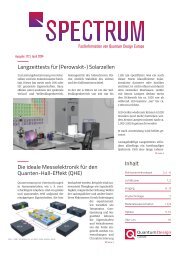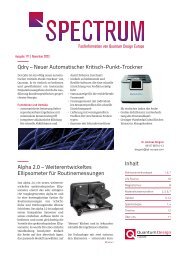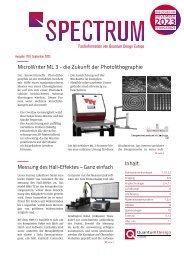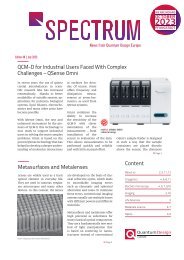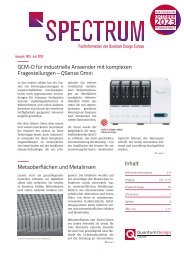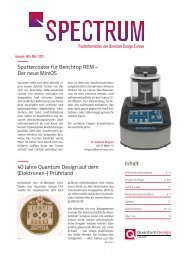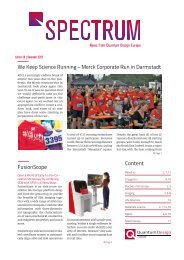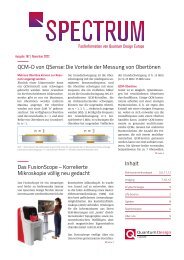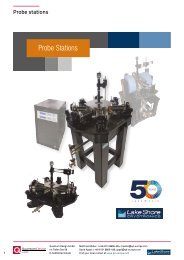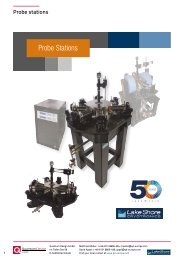Spectrum E38
Create successful ePaper yourself
Turn your PDF publications into a flip-book with our unique Google optimized e-Paper software.
Spectroscopy/Materials science<br />
New energy-resolving detectors for soft and hard X-rays<br />
The detectors operate in list mode,<br />
in which a continuous list of entries<br />
containing this information is<br />
generated from the detector events.<br />
The principle is known from particle<br />
physics. The current Timepix3<br />
sensors allow a time resolution of<br />
1.6 ns without dead time at a count<br />
rate of up to 40 million events per<br />
second.<br />
The comprehensive Pixel Pro software<br />
supports the user in data acquisition<br />
and analysis. Their applications<br />
for Advacam's detectors<br />
include non-destructive fluoroscopy,<br />
X-ray imaging of tissue and<br />
animals, rock samples from geology,<br />
and crystal structure analysis<br />
using X-ray diffraction. Methods<br />
that require energy-resolving detectors<br />
for ions or even neutrons<br />
can use Advapix models for this<br />
purpose.<br />
Please contact us<br />
spectroscopy@qd-europe.com<br />
Quantum efficiency in photovoltaics<br />
Quantum efficiency in photovoltaics<br />
is the ratio of electrons in a<br />
photocurrent to the number of<br />
photons that hit, for example, a solar<br />
cell. Since no one wants to count<br />
individual electrons or photons,<br />
it is common to compare the component<br />
that is to be tested with a<br />
calibrated element. The unknown<br />
quantum efficiency QE is results<br />
from the following:<br />
QE=QE kal<br />
∙<br />
I mess<br />
I kal<br />
QE kal<br />
is the quantum efficiency of<br />
the calibrated component, and the<br />
quotient is the ratio of the two generated<br />
currents. This is subject to<br />
both cells being irradiated with the<br />
same luminous intensity. The image<br />
shows a typical QE measurement<br />
setup (here: on a photodiode). On<br />
the left side radiation of a specified<br />
wavelength (energy) is created. The<br />
chopper creates lighting packages<br />
of a determined frequency. On the<br />
right you can see an M81 with two<br />
current measurement pods. The<br />
main system M81-SSM entangles<br />
and measures the two currents (I mess<br />
and I kal<br />
) which occur at the photodiodes,<br />
with reference to the chopper<br />
frequency and phase.<br />
Compared to the classic measurement<br />
setup with two preamplifiers<br />
and two lock-in channels, this system<br />
not only saves hardware but<br />
also gains metrological flexibility.<br />
For example, the M81 allows DC<br />
measurements like current/voltage<br />
characteristic (IV) curves or creating<br />
a bias (by using additional pods, if<br />
necessary). In the table, you will find<br />
the specifications of the combination<br />
M81-SSM with the current measure<br />
module CM.<br />
In principle, quantum efficiency<br />
can also be measured on other optoelectronic<br />
components, like phototransistors,<br />
photomultipliers, photocathodes,<br />
solar cells and image<br />
intensifiers.<br />
M81 CM-10 Current measure<br />
module<br />
■ Frequency: DC to 100 kHz<br />
■ Best sensitivity: 10 fA<br />
■ Max. range: 100 mA<br />
■ Bias voltage: +/-10 V<br />
Instrumentation of an sEQE measurement using an M81-SSM with CM-10 module. Here, the M81 can be configured to perform<br />
both DC-I-V sweeps and lock-in detection of the AC photocurrent occurring in the device.<br />
Please contact us<br />
materials@qd-europe.com<br />
2




